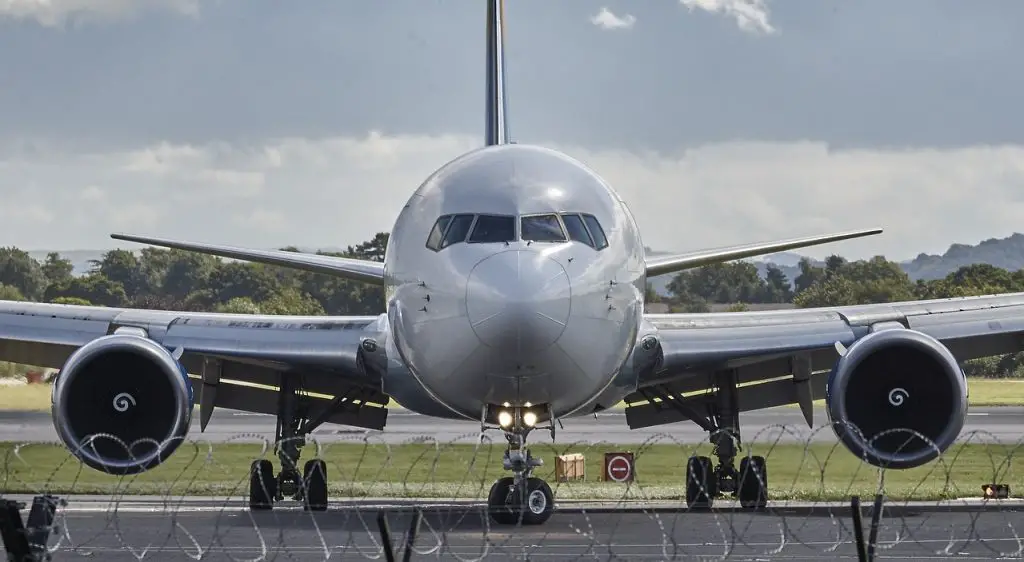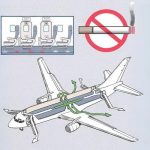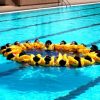Never before have I flown 3 separate flights on the same day. Of course, that is something I’ll have to get used to. Yesterday was my line indoctrination and what a unique day it was.
What Is a Line Indoctrination
For those of you who don’t know, a line indoctrination is a government requirement that all flight attendants must complete before they can receive their competency cards which certify them to fly with passengers.
For most airlines, the flight attendant trainees will ride along on a regularly operating flight with passengers. They’ll sit in a passenger seat and observe how the crew operates the flight. They may even assist with service. They will not assist in any safety procedures, however. The airline will usually only put 2 – 3 trainees on any given flight.
Due to the large number of people graduating from training at around the same time, my company did it a little differently this time around. Instead of a traditional line indoc, they would take two full classes from different cities and put them on a plane without any passengers at all! Yesterday went a little something like this:
The Journey Begins: Travel to Calgary
We arrived at YVR (Vancouver) in the morning. We were scheduled to fly out to Calgary at 10 am on another airline.
Challenges and Adaptations
It was a rough start to the day since we were supposed to be on a 9:00 am flight, but it was cancelled the day before.
We were also having issues with the check-in system and were unable to check-in.
30 minutes before the flight (right at the cut-off for check-in) the airline was able to figure out what happened and print our boarding passes.
We then made a beeline to the gate and made it just in time to start boarding. Since there were so many of us and we were all in uniform, the airline pre-boarded us. How nice!
Once in Calgary, we were quickly shown our airline’s crew room and then were off to the shuttles.
The original schedule for the day gave us 6 hours of downtime, so our airline booked us some day rooms at a nearby hotel.
However, there was a schedule change while we were in the air heading to Calgary. When we arrived at the hotel we learned we only had about an hour and a half of downtime.
Most of us changed out of our uniforms leaving our bags in the hotel rooms, and then went out to find some lunch. By the time we were back from lunch and in our uniforms it was time to jump back into the shuttle and go to the airport.
We arrived about an hour and a half before our flight, which is the base standard for both YVR (Vancouver) and YYC (Calgary) at our airline.
Our supervisors went off to the crew room for the half hour and we took the opportunity to explore the airport. While we were waiting the Calgary class arrived so we were also able to meet them at this time.
Practical Training in the Air
When our supervisors came back we all grabbed our things and made our way to security.
There was more waiting when we got to the gate, as the groomers and caterers were still on the plane. It was being de-catered and cleaned as it had recently just finished a service to YYC.
We were also waiting for our pilots to arrive, but they weren’t too far behind us.
While waiting, our supervisors took the opportunity to brief us on exactly what would be happening. At about the time they finished the briefing, the flight was ready for us to board.
We took our seats and the certified crew onboard started doing their duties.
Our supervisor was narrating everything as it happened so that we knew what was going on.
Once all the pre-flight checks were done and securing the cabin was completed, we pushed back and began to taxi.
Then we stopped. And waited.
And waited some more.
Then the pilot came on the PA. “Sorry folks. We’re delayed. Welcome to (airline’s name).”
He continued to tell us that YYC is experiencing heavy traffic and that we can take off, but we might not be able to land again in Calgary and they needed to figure out the plan.
We were told we may need to fly into Edmonton to complete the line indoc and then wait there until we can go back.
They gave us permission to turn on our phones if we’d like to call home to let people know we could be late. About 5 or 10 minutes after that the seatbelt sign came back on and we began taxying to the runway and then took off. However, we were never informed again about Edmonton.
Simulated Emergency Scenarios
Once in the air things went from normal to abnormal.
But don’t worry! This was planned.
Firstly the pilots simulated light, and then moderate turbulence.
Along with the turbulence the cabin crew followed their procedures and our supervisor was narrating everything they were doing.
We were then informed that we were about to simulate a rapid decompression in a few minutes.
Along with this notification, they reminded us of all the signs and symptoms experienced in a decompression and what to do if one occurs.
After that all was quiet.
The flight attendants were chatting with us in the aisles and we were chatting with those around us.
Another 10 minutes or so went by… I’m not sure exactly how long it was, but it was enough time to let our guard down. Then suddenly we heard the captain’s voice over the PA. “BANG! PHSSSSSSssssss….”
At this time the Flight Attendants donned fake oxygen masks that had “dropped down” from the overhead compartments and the plane began rapidly descending.
After a few minutes we reached 12,000 feet and the captain announced that it was now safe to remove our masks.
At this point, the cabin crew began following their procedures for decompression, all the while our supervisor is narrating everything that is happening.
Since we were already at such a low altitude, the next step was a simulation of an aborted landing. An aborted landing is when the aircraft is making its final approach to the runway and the pilot decides not to land. This might happen if there is an obstruction on the runway. A family of ducks for example.
I suppose an aborted landing feels similar to flooring the gas pedal in your car. The captain takes the throttle to its highest setting and we start ascending very quickly. It’s very bumpy, but personally I thought it was very fun!
At this point, we were more or less finished.
All that was left was landing. Although the landing itself was normal, the crew treated it as an emergency landing.
I’ll spare you the details on how an emergency landing works since I’ve written a whole post of its own on that subject already.
Just before landing, we were informed that we were in fact landing in Calgary, phew!
Although, I wasn’t terribly worried even if we did need to land in Edmonton. I’m flexible, it’s all good!
Once on the ground the crew “canceled” the emergency, since there was no need to evacuate the aircraft and we’re all trained already on how to do that.
The flight crew then made their final “Welcome to Calgary, the local time is…” announcements and we left the aircraft.
Once we were on through the airport and on the unsecured side, we said our goodbyes to the Calgary class and headed to the check-in kiosks to pick up our boarding passes to go home.
The flight home was simple and pleasant. We were fortunate enough to have a very nice flight crew who spoiled us!
That particular airline recently started charging for headsets, however, the Flight Attendants gave each of us a free headset, extra snacks, and a full can of soft drink instead of just a plastic cup.
I suppose it’s a perk that comes with deadheading in uniform, even on another carrier!
Returning Home and Reflections on the Day
It was a long day, however, it was probably part of what I’ll be working regularly from now on.
Speaking of which, tomorrow is my first flight as a Flight Attendant, am I excited? You bet!




I’m a Flight Attendant in Training too. Tomorrow we will have our line Indoc, and so excited about it. It helps so much for what to expect reading your blog.. great job, congratulations